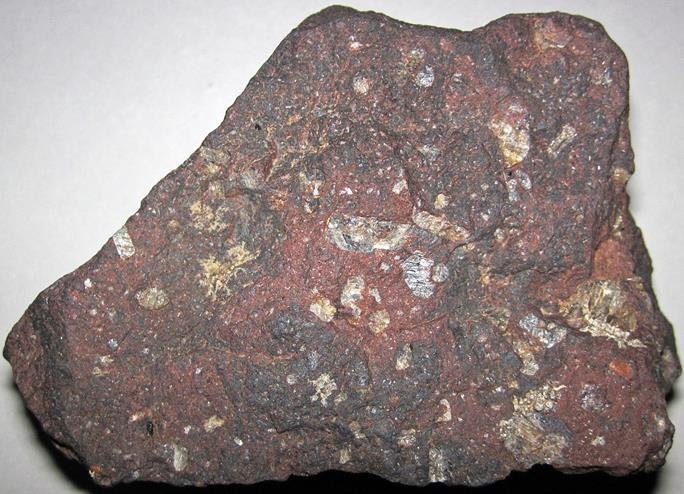Porphyritic basalt rocks have large, well-formed grains of calcic plagioclase, augite, olivine, and sometimes hornblende in fine-grained dark-gray to black matrix.
The matrix will have mainly calcic plagioclase and augite. Also, it may have small amounts of olivine, enstatite, pigeonite, interstitial glass, feldspathoids/quartz, and biotite or hornblende less often.
Common accessory minerals in the matrix include ilmenite, spinel, magnetite, chromite, and apatite.
The large, well-formed, often subhedral to euhedral crystals are called phenocrysts, while the fine-grained matrix is the groundmass.
Different mineral grain phenocrysts can sometimes occur in clusters to form a cumulophyric texture. If phenocrysts of the same minerals cluster together, you will have glomeroporphyritic basalt.
Clustering happens because it is energetically favorable as it reduces the interface between crystals and melt compared to those dispersed in the melt. It is more like surface tension seen in liquids.

Note: Porphyritic basalts are also known as basalt porphyry or phyre (US). Porphyry is a noun or name used for rock with two distinctive grain sizes, while porphyritic or phyric (US) is an adjective that describes the resultant texture.
What do porphyritic rocks look like?
Porphyritic basalt will have large phenocrysts visible on a hand specimen with a naked eye set in a dark gray or black groundmass. This groundmass has grains you cannot see without a microscope.
These phenocrysts are white or gray plagioclase (labradorite or sometimes bytownite), glassy green olivine, black augite, or occasionally yellow, brown, or orange hornblende set in a dark gray or black groundmass.
Besides porphyritic texture, these rocks can have other textures, including vesicular, characterized by pits or voids, amygdaloidal, or ophitic/subophitic.
Amygdaloidal basalt forms when the vesicles in basalt are filled with secondary minerals.
On the other hand, ophitic occurs when pyroxene, olivine, or other minerals enclose plagioclase laths. If they only partly surround plagioclase laths, the texture is subophitic.
How does basalt porphyry form?
The bimodal grain sizes suggest that crystallization happened mostly in two cooling stages.
Phenocrysts formed during an earlier, slow-cooling stage. This happened deep inside the Earth’s crust. The slow cooling favored crystal growth over nucleation because it caused a low level of supersaturation or subcooling.
Therefore, few crystals nucleated but grew freely in magma, mostly with melt. This created the well-formed euhedral to subhedral large grains. Such crystals have easy-to-recognize, well-formed faces.
The magma with already formed large crystals then rose and erupted. After the eruption, cooling was quick.
This caused supercooling, which resulted in a high nucleation rate. The high nucleation rate formed a fine-grained or aphanitic texture that forms the groundmass.
Lastly, aphanitic crystals aren’t visible with an aided eye. To see and identify such crystals, one needs a microscope.
Where does it occur?
Porphyritic rocks occur where other basalt rocks are found, especially in lava flows. These places include ocean floors, oceanic islands with vulcanism, flood basalts in large igneous provinces (LIPs), and continental rifts.
Some locations where basalt porphyries are in the US are Hawaii Island and Columbia River in Idaho. Also, they are common in Menominee Group in Minnesota, Hook Mt. Basalt in Basalt, and Ossipee Mountain Complex of Kingsley in New Hampshire.
More locations are in California, Texas, New England, Oregon, and Washington, among other states.
Uses of porphyritic basalt
The use of porphyritic basalt is similar to that of any other basalt rock. They include industrial uses, dimensional stones, making aggregate, landscaping, grinding stones, etc.
For instance, these rocks aggregate for concrete, railroad ballast, roading industry, fill, or gravel for unpaved pathways, patios, or driveways.
On the other hand, cut and polished basalt can make tiles, kitchen countertops, pavers, building stones, statues, headstones, etc.
Lastly, industrial uses include making fiber, pipes, and pipelines.
